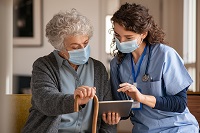COVID@Home Monitoring for Primary Care is supported by centralized procurement and distribution of oxygen saturation monitors (by the Ministry of Health) for primary care practices to lend to patients. Implementing this new program through primary care teams in the community can extend the reach of existing remote care monitoring programs, and will create new capacity in areas that currently do not have access to remote care. Home monitoring also helps support appropriate escalation pathways for COVID-19 patients who require hospital care, and early detection for required escalations. On the other end of the spectrum, COVID@Home monitoring can also support the earlier discharge of medically stable COVID-19 patients on short-term oxygen and who require continued monitoring and oxygen weaning (along with any continued medication management) in the home setting.
distribution of oxygen saturation monitors (by the Ministry of Health) for primary care practices to lend to patients. Implementing this new program through primary care teams in the community can extend the reach of existing remote care monitoring programs, and will create new capacity in areas that currently do not have access to remote care. Home monitoring also helps support appropriate escalation pathways for COVID-19 patients who require hospital care, and early detection for required escalations. On the other end of the spectrum, COVID@Home monitoring can also support the earlier discharge of medically stable COVID-19 patients on short-term oxygen and who require continued monitoring and oxygen weaning (along with any continued medication management) in the home setting.
Patients often have questions for health care providers and may be anxious about having COVID-19. With COVID@Home monitoring, primary care teams can help address patient fears and concerns while monitoring clinical symptoms for signs of deterioration. Close monitoring in primary care supports, and essentially triages, patients in the community so that those who do not require emergency care can avoid going to the hospital, and patients who do need more intensive care can be escalated to the hospital in a timely manner.
Ontario Health also hosts regular community of practice meetings to share the most up-to-date clinical pathways, answer questions, and to support primary care practices as they get started on monitoring their COVID-19 patients.
If you have any questions about the program please contact Janine Theben at janine.theben@ontariohealth.ca. If you have specific clinical questions please contact Dr. Dee Mangin at mangind@mcmaster.ca.
